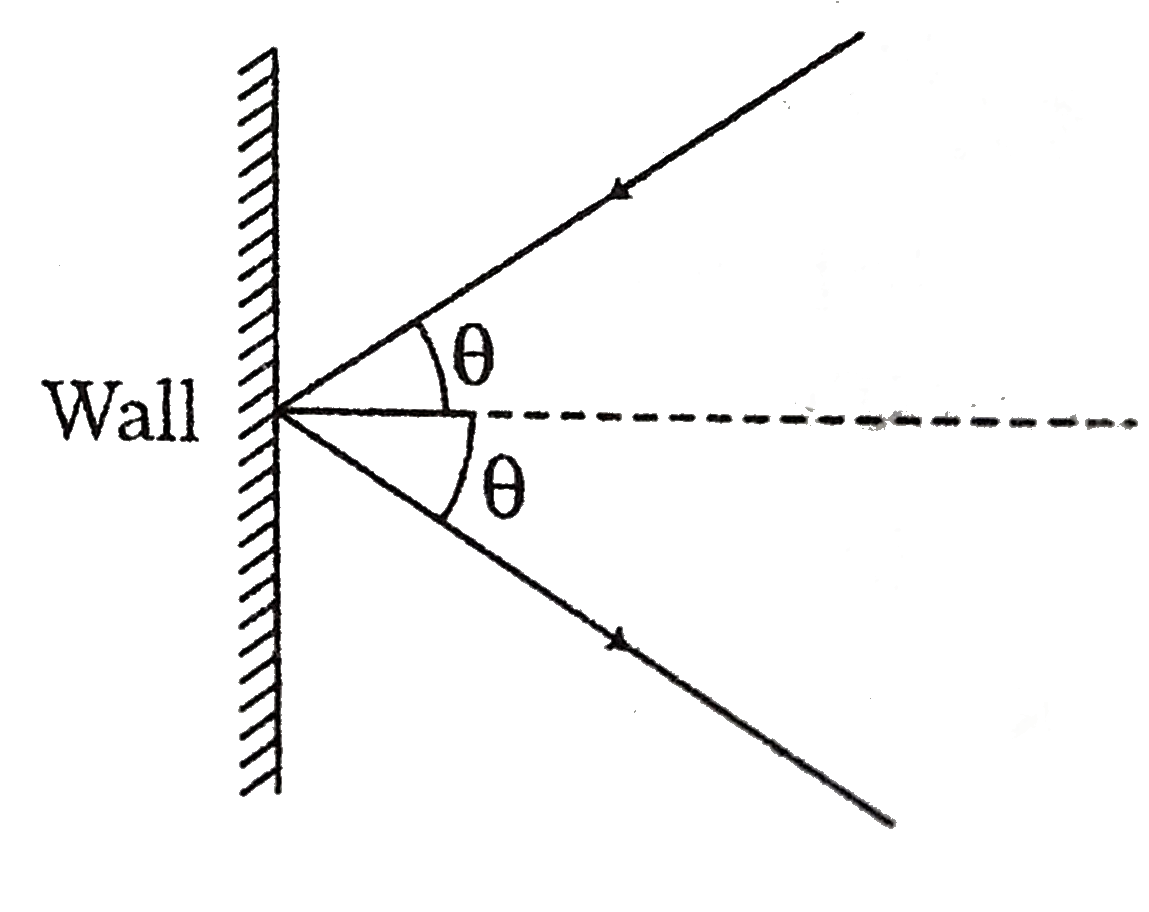1023 molecules of a gas, each having a mass of 3×10−27 kg strike per second per sq. cm. of a rigid will at an angle of 60∘ with the normal and rebound with a velocity of 500m/s. What is the pressure exerted by the gas molecules on the wall?
500N/m2
1000N/m2
1500N/m2
2000N/m2
The correct Answer is:C
To find the pressure exerted by the gas molecules on the wall, we can follow these steps:
Step 1: Understand the Given Information
We have:
- Number of molecules, N=1023
- Mass of each molecule, m=3×10−27 kg
- Velocity of molecules, v=500 m/s
- Angle of incidence with the normal, θ=60∘
Step 2: Convert Mass Flow Rate to SI Units
The mass flow rate per unit area is given as 3×10−27 kg/s/cm². We need to convert this to m²:
Mass flow rate per unit area=3×10−27kg/s/cm2=3×10−27kg/s×104cm−2=3×10−23kg/s/m2
Step 3: Calculate the Change in Momentum for One Molecule
The change in momentum (Δp) for one molecule when it strikes the wall and rebounds is given by:
Δp=mvcos(θ)−(−mvcos(θ))=2mvcos(θ)
Substituting the values:
Δp=2×(3×10−27kg)×(500m/s)×cos(60∘)
Since cos(60∘)=12:
Δp=2×(3×10−27)×500×12=3×10−27×500=1.5×10−24kg m/s
Step 4: Calculate the Total Change in Momentum for All Molecules
The total change in momentum per second (force) from all molecules is:
F=N×Δp=1023×1.5×10−24=1.5×10−1N
Step 5: Calculate the Pressure
Pressure (P) is defined as force per unit area. The area is 1m2:
P=FA=1.5×10−1N1m2=0.15N/m2=150Pa
Final Answer
The pressure exerted by the gas molecules on the wall is 150Pa.
---
We have:
- Number of molecules, N=1023
- Mass of each molecule, m=3×10−27 kg
- Velocity of molecules, v=500 m/s
- Angle of incidence with the normal, θ=60∘
The mass flow rate per unit area is given as 3×10−27 kg/s/cm². We need to convert this to m²:
Mass flow rate per unit area=3×10−27kg/s/cm2=3×10−27kg/s×104cm−2=3×10−23kg/s/m2
The change in momentum (Δp) for one molecule when it strikes the wall and rebounds is given by:
Δp=mvcos(θ)−(−mvcos(θ))=2mvcos(θ)
Substituting the values:
Δp=2×(3×10−27kg)×(500m/s)×cos(60∘)
Since cos(60∘)=12:
Δp=2×(3×10−27)×500×12=3×10−27×500=1.5×10−24kg m/s
The total change in momentum per second (force) from all molecules is:
F=N×Δp=1023×1.5×10−24=1.5×10−1N
Pressure (P) is defined as force per unit area. The area is 1m2:
P=FA=1.5×10−1N1m2=0.15N/m2=150Pa
The pressure exerted by the gas molecules on the wall is 150Pa.
Topper's Solved these Questions
- BOOK - MARVEL PUBLICATIONCHAPTER - KINETIC THEORY OF GASES ,THERMODYNAMICS AND RADIATIONEXERCISE - TEST YOUR GRASP - 930videos
KINETIC THEORY OF GASES ,THERMODYNAMICS AND RADIATION
- BOOK - MARVEL PUBLICATIONCHAPTER - INTERFERENCE AND DIFFRACTIONEXERCISE - TEST YOUR GRASP20videos
INTERFERENCE AND DIFFRACTION
- BOOK - MARVEL PUBLICATIONCHAPTER - MAGNETIC EFFECTS OF ELECTRIC CURRENTEXERCISE - MCQ195videos
MAGNETIC EFFECTS OF ELECTRIC CURRENT
Similar Questions
The mass of hydrogen molecule is 3.23×1023 hydrogen molecules strike 2cm2 of a wall per second at an angle of 45∘ with the normal when moving with a speed of 105cms−1, what pressure do they exert on the wall ? Assume collision to be elasitc.
View SolutionThe density of a gas is 6×10−2kg/m3 and the root mean square velocity of the gas molecules is 500 m/s. The pressure exerted by the gas on the walls of the vessel is
View Solution
Knowledge Check
- Question 1 - Select One
The mass of hydrogen molecule is 3.32×10−27 kg. If 1023 hydrogen molecules strick per second at 2 cm2 area of a rigid wall at an angle of 45∘ from the normal and rebound back with a speed of 1000 ms−1, then the pressure ezxeted on the wass is
 A2.34×103 PaB0.23×106PaC0.23×103PaD23.4×103Pa
A2.34×103 PaB0.23×106PaC0.23×103PaD23.4×103Pa - Question 2 - Select One
500 steel ballls each of mass 1 gram strike normally one sq. cm area of a metal plate per second, with a velocity of 10 m/s and rebound with the same velocity. What is the pressure exerted by the balls on the surface of the plate?
A104N/m2B105N/m2C2×105N/m2D4×104N/m2 - Question 3 - Select One
The mass of hydrogen molecule is 3.23×10−27Kg. If 1023 hydrogen molecules strike 2cm2 of a wall per second at an angle of 45∘ with the normal when moving with a speed of 105cms−1, what pressure do they exert on the wall ? Assume collision to be elastic.
A1350N/m2B2350N/m2C3320N/m2D1660N/m2
A ball of mass 500 gram strikes a wall with a velocity of 80 m/s and rebounds with the same velocity. If the tme of contact is 1/30 sec, then the force exerted by the ball on the wall is
View SolutionA cricket ball of mass 0.5 kg strikes a circket bat normally with a velocity of 20 m s−1 and rebounds with a velocity of 10 m s−1. The impulse of the force exerted by the ball on the bat is
View SolutionA jet of water with cross section of 6cm2 strikes a wall at an angle of 60∘ to the normal and rebounds elastically from the wall without losing energy. If the velocity of the water in the jet is 12m/s, the force acting on the wall is
View SolutionA ball of mass 0.1 kg strikes a wall normally with a speed of 30ms−1 and rebounds with a speed of 20ms−1. The impulse of the force exerted by the wall on the ball is
View Solution10,000 small balls, each weighing 1 gm , strike one square cm of area per second with a velocity 100 m/s in a normal direction and rebound with the same velocity. The value of pressure on the surface will be
View Solution

